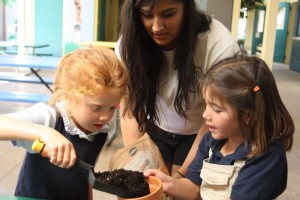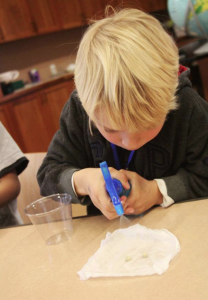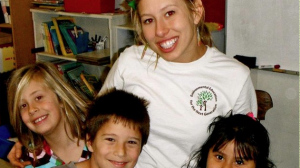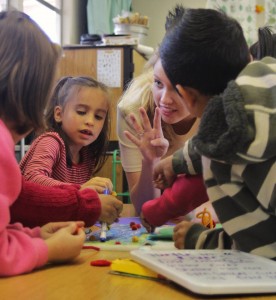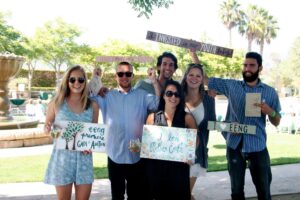Inspiring right?! Now you see why I had to learn more and Ryland was so kind to take time out of his busy schedule to do this phone interview which I hope inspires you as much as it has me!
1. What first made you want to start Sprout Up and what was the first step you took to make it happen?
Ryland explained how the first experience that made him want to get involved in environmental education was when he was teaching at a summer surf camp. One week he was teaching a developmentally delayed 8 year old boy how to surf and at the end of the week the boy’s parents came to Ryland and thanked him in such a heartfelt way explaining how their child had never been as present, engaged, and connected with them as he had been that week. That experience truly illustrated the power of nature to help people connect. Ryland realized how that when 1 person teaches, many people learn and that it was this understanding that pushed him into taking those first steps toward working in education for the environment. By sharing his personal connections with the natural world and getting youth excited and engaged with nature, Ryland feels he can give back to both the natural world and his community.
Sprout Up founder, Ryland King
2. Do you have a favorite lesson that you teach in schools and what about it makes it your favorite?
Ryland likes the reuse lesson plan. This is a project where the students are given reusable grocery bags to decorate with a favorite nature scene. The key is that they then write a kind message on the benefits of reusing to their parent or caretaker on the bag. Ryland feels that this project in particular highlights the amplification of the program because the children go home with the bag featuring a kind message which engages the adult, inspiring them to use the bag, which grows wider conversations in the home and community about why it is important to reuse items. Ryland told a great story about being in the grocery store checkout line one day and observing an adult ahead of him using one of these bags. The cashier commented on the bag and the adult shared the story behind the bag. This got another customer in line involved in the conversation and created a dialogue about reusing bags between a group of former strangers that reached out into the community in a meaningful and inspiring way. He sees this as an example of the ability of a child’s creativity to affect the lives of people in a way that ricochets out into the greater community.

3. Do you remember a particular childhood nature experience that sparked your sense of wonder and helped create your environmental ethic?
To this question, Ryland said that of course there were a series of events and a lifetime experiencing nature that created his foundation, but that there are a few that stand out in particular. One such event was when he was in 8th grade he went on a trip to the amusement park Great America and then, the next day, he went surfing. In that pivotal surf session he experienced perhaps the best waves of his young life up to that point. He remembers coming in onto the beach and excitedly telling his father, “This is 1000 times better than a theme park!” And explained to his dad that he didn’t want to go to theme parks anymore. As they were talking and walking up from the beach, he and his dad picked up trash, as they normally did. It was at this impressionable moment that it hit Ryland that the beach and ocean were something he wanted to care for and to share with others.

Through creating a program of mentors that model behaviors and ideas, he has been able to take that inspiration, connection, and happiness he felt that day brought on by the epic waves and share that in the classroom with children who may not otherwise get opportunities to connect with the natural world and have environmentally responsible values modeled for them. When the college age mentors enter the classroom, they share not only information and experiences with the students, they share smiles and special handshakes. The connect in a way that is different than that of a teacher because the Sprout Up mentors are fun, young, cool, environmentalists. They are people the kids want to be like, and they provide a positive model of how to be an environmental steward that leaves a long lasting impression. By exclusively using college age young adults to teach in the schools, Sprout Up also provides role models in higher education to the children. In some schools Sprout Up serves, 95% of parents do not speak english and some even have education levels no higher than 1st grade themselves. This gives these children a clear vision and model that they too can go to college by bringing the coolness of learning and the natural world into their lives thereby promoting a love of both learning and the Earth.
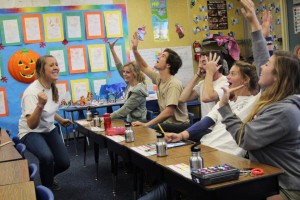
4. What is your favorite smell in nature and is there a story why?
This might seem like a strange question at first, but I asked this question because I love smells in nature and I wanted to explore how others with a strong connection to the natural world feel about smells. The human sense of smell is one of our most powerful senses, especially when it comes to triggering emotional memory. The olfactory nerve, responsible for registering smells in our brains, is one of the few nerves that connect directly to the brain. Information from smells is categorized and stored in our long-term memory. Scientists believe that the power of smell to strongly trigger memories is because of the olfactory system’s close anatomical ties to the areas of the brain that are known to be involved in emotion and place memory.
Ryland said the smell of the redwood forest is his favorite smell in nature. As a child he camped a lot beneath these giant trees and the fresh smell of the sequoias reminds him of a sense of being in tune.
I hope to smell this smell one day too! It sounds euphoric!
Reusable Bags
In honor of Sprout Up and Ryland’s inspiring work and interview I decided to borrow his idea and help spread enthusiasm about reusing. So here is an adapted version of the lesson Ryland described to us earlier. I hope after you create these bags with your students that you overhear a conversation spreading the positive message of environmental connection and responsibility in the grocery line too! Enjoy and don’t forget, the kind message on the bag is the most important part!
Materials
Cloth markers
Paint pens
Puffy pens for fabric
Canvas or cloth reusable grocery bags
Procedure
Engage the students in a discussion about why it is important to reuse items. Here are some book suggestions to assist with these concepts you could use:
Don’t Throw That Away!: A Lift-the-Flap Book about Recycling and Reusing by Lara Bergen and Betsy Snyder
My Bag and Me! By Karen Farmer
The Three R’s: Reuse, Reduce, Recycle by Nuria Roca, Rosa M. Curto
The Dumpster Diver by Janet S. Wong and David Roberts
Garbage and Recycling by Rosie Harlow and Sally Morga
Bob’s Recycling Day by Annie Auerbach and Vince Giarrano
Eileen Green The Recycling Queen by Penelope Dyan
Recycling (Cool Science) by Charlotte Wilcox
Kid Heroes of the Environment by Earthworks Group and Catherine Dee
Explain to the students that they are going to create a bag that will inspire and teach the grown ups in their lives the importance of reusing.
Show them where on the bag they will be drawing and any special info needed for using the fabric pens and markers.
Recommend a a good space on the bag for writing their kind message to their grown up and first have students brainstorm their message and write it on paper. They may want to write the message on the bag in pencil first and then trace over it with the fabric pens, but that may depend on the age and skill level of the students.
Have the children create their bags and send them home with enthusiasm!

